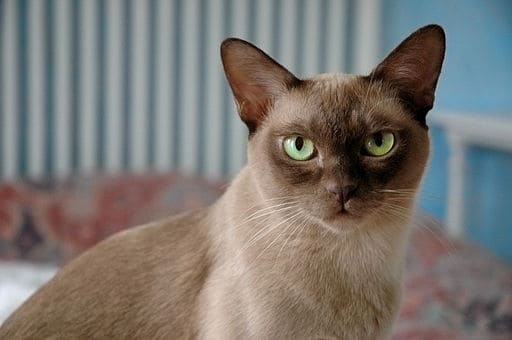Protecting the health of our four-legged friend is the first step to live long and peacefully by his side: here are the common diseases of Burmese.

Generally, the Burmese is a long-lived and healthy cat. It is up to us, however, to always keep the quality of his life high. As? By taking care of his diet, satisfying his ethological needs and making sure of his state of health. Let’s find out what are the common diseases of Burmese, how to recognize them and how to intervene.
Common diseases of Burmese: the complete list

As we have anticipated, specimens of this breed tend to live a long time. The average duration of their life, in fact, is 15 years.
However, attention should be paid to a number of common diseases that affect the Burmese cat.
In particular, these are hereditary diseases, which are genetically transmitted from one generation to another. The main diseases include:
- Hypertrophic cardiomyopathy;
- Hypokalemic myopathy;
- Obesity;
- GM2 gangliosidosis.
Not just genetic diseases: to avoid the onset of infections, skin disorders and other diseases of various kinds, it is essential to know how to best take care of the Burmese cat. To find out, all you have to do is consult this comprehensive article.
Hypertrophic cardiomyopathy
Hypertrophic cardiomyopathy opens the list of common diseases in Burmese.
It is a hereditary disease that affects the cat’s heart, especially the left ventricle. As its walls thicken, it shrinks in thickness and stiffens, compromising blood circulation.
Among the main symptoms of this disease are:
- Decreased appetite;
- Heart murmur;
- Difficulty in breathing;
- Decreased appetite.
Unfortunately, to date there is no definitive cure for this pathology. The prognosis is variable, depending on the progress of the disease.
Hypokalemic myopathy
Hypokalemic myopathy is one of the common diseases in the Burmese cat.
This pathology affects the animal’s musculoskeletal system, compromising the functioning of the muscle fibers.
It is determined by the lack of potassium, which is fundamental in the biochemical mechanism underlying the contraction and movement of muscles. In the Burmilla cat, this pathology is caused by the presence of a recessive gene and causes the following symptoms:
- Tiredness;
- Periodic paralysis;
- Muscle fatigue;
- Difficulty moving
- Pain and apathy;
- Abnormal gait.
The treatment of hypoalkalemic myopathy involves the administration of potassium to the cat, in order to restore normal values. In most cases, the treatment is successful.
Obesity
Obesity is one of the common diseases in Burmese. The specimens of this breed, in fact, are predisposed to the accumulation of excess weight.
Obesity, in turn, risks further compromising the cat’s health, as it is associated with the onset of other diseases, such as:
- Skin disorders;
- Joint ailments;
- Heart disease;
- Diabetes mellitus.
The main causes of obesity include a sedentary lifestyle and poor nutrition.
For this reason, it is essential to plan a healthy, balanced and nutritious food plan together with the vet, stimulating him with games and activities throughout the day.
GM2 gangliosidosis
Finally, GM2 gangliosidosis closes the list of common diseases in Burmese.
This is a rare genetic disorder that causes lipids to accumulate in the cat’s body. In particular, they settle inside the nervous and peripheral systems of the animal, compromising cellular function.
This disease is caused by the absence of beta-hexosaminidase enzymes (A and B). The main symptoms of gangliosidosis include:
- Nystagmus;
- Ataxia;
- Liver enlargement;
- Tremor;
- Decreased appetite.
Unfortunately, there is currently no cure for this condition. The only possible treatments include monitoring the cat’s blood sugar and hydration levels, to ensure that the last part of his life is spent peacefully.






